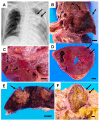Comparison Approach for Identifying Missed Invasive Fungal Infections in Formalin-Fixed, Paraffin-Embedded Autopsy Specimens
- PMID: 35448568
- PMCID: PMC9030445
- DOI: 10.3390/jof8040337
Comparison Approach for Identifying Missed Invasive Fungal Infections in Formalin-Fixed, Paraffin-Embedded Autopsy Specimens
Abstract
Invasive fungal infection (IFI) has a high mortality rate in patients who undergo hematopoietic stem cell transplantation, and it is often confirmed by postmortem dissection. When IFI is initially confirmed after an autopsy, the tissue culture and frozen section are challenging to secure, and in many cases, formalin-fixed, paraffin-embedded (FFPE) samples represent the only modality for identifying fungi. Histopathological diagnosis is a useful method in combination with molecular biological methods that can achieve more precise identification with reproducibility. Meanwhile, polymerase chain reaction (PCR) using fungal-specific primers helps identify fungi from FFPE tissues. Autopsy FFPE specimens have a disadvantage regarding the quality of DNA extracted compared with that of specimens obtained via biopsy or surgery. In the case of mucormycosis diagnosed postmortem histologically, we examined currently available molecular biological methods such as PCR, immunohistochemistry (IHC), and in situ hybridization (ISH) to identify fungi. It is reasonable that PCR with some modification is valuable for identifying fungi in autopsy FFPE specimens. However, PCR does not always correctly identify fungi in autopsy FFPE tissues, and other approaches such as ISH or IHC are worth considering for clarifying the broad classification (such as the genus- or species-level classification).
Keywords: Cunninghamella; autopsy; formalin-fixed paraffin-embedded (FFPE); immunohistochemistry (IHC); in situ hybridization (ISH); invasive fungal infection (IFI); mucormycosis; polymerase chain reaction (PCR).
Conflict of interest statement
All authors declare that they have no competing interests.
Figures




Similar articles
-
[Histopathological Diagnosis of Invasive Fungal Infections in Formalin-Fixed and Paraffin-Embedded Tissues in Conjunction with Molecular Methods].Med Mycol J. 2018;59(1):E7-E18. doi: 10.3314/mmj.17-00016. Med Mycol J. 2018. PMID: 29491339 Japanese.
-
Histopathological study on the prevalence of trichosporonosis in formalin-fixed and paraffin-embedded tissue autopsy sections by in situ hybridization with peptide nucleic acid probe.Med Mycol. 2020 Jun 1;58(4):460-468. doi: 10.1093/mmy/myz096. Med Mycol. 2020. PMID: 31535126 Free PMC article.
-
Comparison between the effectiveness of polymerase chain reaction and in situ hybridization in detecting the presence of pathogenic fungi by using the preserved DNA in formalin-fixed and paraffin-embedded tissues.Jpn J Infect Dis. 2013;66(3):173-9. doi: 10.7883/yoken.66.173. Jpn J Infect Dis. 2013. PMID: 23698476
-
[Development and evaluation of nucleic acid-based techniques for an auxiliary diagnosis of invasive fungal infections in formalin-fixed and paraffin-embedded (FFPE) tissues].Med Mycol J. 2012;53(4):241-5. doi: 10.3314/mmj.53.241. Med Mycol J. 2012. PMID: 23257724 Review. Japanese.
-
Technical Aspects and Applications for Developing in situ Hybridization Procedures for Formalin-Fixed and Paraffin-Embedded (FFPE) Tissues for Diagnosis of Fungal Infections.Med Mycol J. 2017;58(1):E33-E37. doi: 10.3314/mmj.16-00025. Med Mycol J. 2017. PMID: 28250362 Review.
Cited by
-
A Pathology-based Case Series of Influenza- and COVID-19-associated Pulmonary Aspergillosis: The Proof Is in the Tissue.Am J Respir Crit Care Med. 2023 Aug 1;208(3):301-311. doi: 10.1164/rccm.202208-1570OC. Am J Respir Crit Care Med. 2023. PMID: 37311243 Free PMC article.
-
Recent Advances in Diagnostic Approaches for Mucormycosis.J Fungi (Basel). 2024 Oct 19;10(10):727. doi: 10.3390/jof10100727. J Fungi (Basel). 2024. PMID: 39452679 Free PMC article. Review.
-
Establishment and validation of a simple and accurate qPCR detection method for Haemophilus parasuis.Sci Rep. 2025 Mar 10;15(1):8264. doi: 10.1038/s41598-025-92803-1. Sci Rep. 2025. PMID: 40065140 Free PMC article.
References
-
- Lockhart S.R., Bialek R., Kibbler C.C., Cuenca-Estrella M., Jensen H.E., Kontoyiannis D.P. Molecular Techniques for Genus and Species Determination of Fungi from Fresh and Paraffin-Embedded Formalin-Fixed Tissue in the Revised EORTC/MSGERC Definitions of Invasive Fungal Infection. Clin. Infect. Dis. 2021;72:S109–S113. doi: 10.1093/cid/ciaa1836. - DOI - PMC - PubMed
Grants and funding
LinkOut - more resources
Full Text Sources

